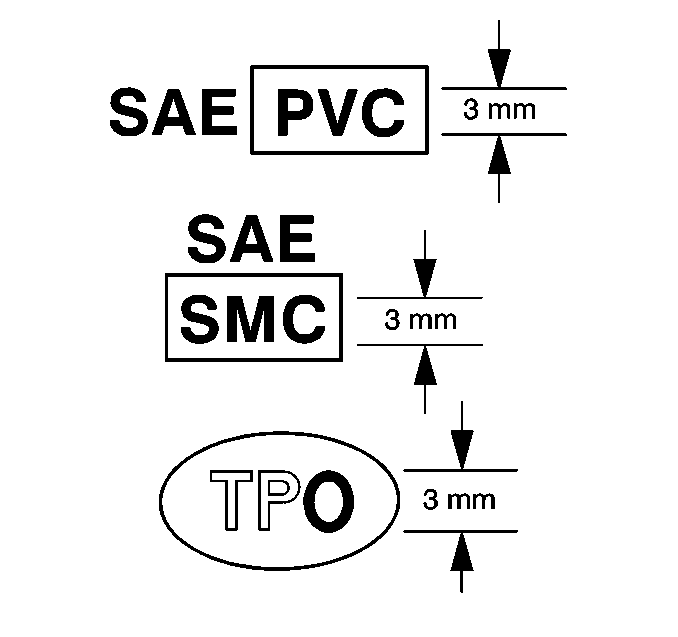Chevrolet Sonic Repair Manual: How to Identify Plastic Parts

Plastic parts can be identified by the SAE code, which is usually found on the rear of the part, and/or by the characteristics of the plastic. Knowing the type of plastic aids in selecting the proper repair materials and in selecting the proper repair procedure.
Look for the SAE code stamped into the part.
- Code Found
-
Match the code to those in the plastic identification chart to determine whether the plastic is thermoplastic or thermoset plastic, and whether the plastic is rigid or flexible. Refer to Plastic Identification and Refinishing Systems.
- No Code Found
-
Warning:
Do NOT use a plastic burn test to distinguish the type of plastic. The burn test produces vapors which are harmful.
Perform one or both of the following tests to determine if the part is thermoplastic polyolefin or thermoset non-polyolefin.
- Float Test
-
- Cut a shaving of plastic from the back of the part.
The shaving should be free of mold release agents and paint.
- Place the shaving in a container of water.
- Thermoplastic polyolefin floats.
- Thermoset non-polyolefin sinks.
- Cut a shaving of plastic from the back of the part.
- Abrasion Test
-
- Sand a spot near the damaged area with Grade?€‰36 Roloc Disc.
- Thermoplastic polyolefin material melts or frays when sanded.
- Thermoset non-polyolefin material sands cleanly.
Thermoplastic and thermoset plastics can be either rigid or flexible. Thermoplastic plastic parts are best repaired with a hot iron plastic material-feed welder, but are usually replaced. Thermoset plastic can be repaired with epoxy or other more rigid 2 package repair material.
For general repair instructions, refer to General Plastic Repair.
 General Plastic Repair
General Plastic Repair
Warning: In order to reduce the risk of personal injury when exposed
to toxic fumes while grinding, cutting, or applying repair material on any type
of sheet molded compound or RIM rigid plas ...
 Plastic Collar Quick Connect Fitting Service
Plastic Collar Quick Connect Fitting Service
Removal Procedure
Warning: Refer to Gasoline/Gasoline Vapors Warning.
Note: There are several types of plastic collar fuel and evaporative
emission quick conne ...
Other materials:
Drive Range, First Gear Engine Braking (Gen 1)
When the gear selector lever is moved to the Drive (D) range from the Neutral
(N) position, the transmission will provide engine braking. In this operating range,
the normally-low 1234 pressure control solenoid 5 is commanded ON and, in the engine
braking mode, the following changes occur with ...
Water Pump Pulley Replacement (LUW)
Removal Procedure
Remove the air cleaner housing. Refer to Air Cleaner Assembly Replacement.
Support the engine with a suitable jack.
Remove the engine mount. Refer to Engine Mount Replacement.
Raise engine to access the bolts.
Loosen the 3 water pu ...
Engine Coolant Thermostat Replacement (LUW)
Removal Procedure
Warning: Refer to Battery Disconnect Warning.
Disconnect the battery negative cable. Refer to Battery Negative Cable
Disconnection and Connection.
Drain the coolant. Refer to Cooling System Draining and Filling.
Disconnect the en ...
0.0042
